Learning how to start a blog was the best decision I ever made…

Let me tell you how my life was before… and maybe you can relate:
- I worked 40 hours a week, sometimes a lot more, for a salary that sometimes kept up with the cost of living.. but often did not.
- I went back to college while working full-time, incurring student loans, all so I could make a livable wage
- It didn’t seem to matter how hard I worked… it was a slow climb just to try to get ahead
- Every time I wanted to take a day off, it was a negotiation with consequences
- Sometimes my boss wanted me to stay late or work on my own time so it “looked good” even if I didn’t have work to do
- I was tired and stressed all the time. I never got enough sleep, my body hurt constantly and I hated the commute
- I felt like I never had enough time to do all the things in life that really gave me joy
I remember the day it all changed. My website was a month or two old. It was a spring weekend morning and my husband and I were walking our two dogs in a nearby park. I was telling him all the things I’d observed and what I was learning (things I’ll share with you too) and I was listing out all the key components I thought I needed to succeed. And then it happened and these words tumbled out of my mouth:
“You know… I think I can make 6 figures with this.”
And that was the moment I knew. I KNEW I could 100% do this. In that instant I saw the path. That it was methodical. It was attainable. And I knew in the deepest part of my soul that I was capable of making it happen.
And I did just that.
Now.. it was not instant. I worked hard. First, I earned enough to buy us an extra dinner out…which honestly.. was completely amazing. Then I earned enough to pay our mortgage payment. Also.. amazing.
Pretty soon I was making a part time income online while working full-time. One day I realized I was basically making the SAME income with the side blogging gig as I did with my full-time job!
I wondered.. how big could I grow this business if I could just focus all my energy on the online gig.
So, I quit the day job to go all in on my blog and later that year I hit my 6-figure goal. And I keep growing. The sky is the limit.

Now I wake up, rested and refreshed. I plan my days the way I want, working when I choose and, more importantly, deciding when it’s time for me and other priorities in my life. I focus my work time on things that give me the greatest return on investment so that I can be the most productive, while increasing my income.
I’ve helped other bloggers improve their productivity. I use a finance term called ROI. ROI is an acronym for ‘Return on Investment’ and simply means getting the most profit out of my most precious “investment”, which is my time. I’m very good at ROI.
I want to teach you how to improve your ROI too. But first we need to go over the very basics on how to start a blog, so we are all on the same page!
How To Start A Blog
Starting a blog is not difficult. You can have your website up and running in less time than it takes to make dinner. You don’t need to know computer coding to start a successful blog. You don’t need a college degree.
I know bloggers who started as young as 16 years old and others who started as grandmas. If they can do it, so you can you!
This in-depth guide will take you through how to start a blog step-by-step!
Core Principles of Blogging
Here at Creative Blogger Blueprint, I teach you to methodically learn new skills to reach your goal of profitability as quickly and efficiently as possible. I call this ‘Return on Investment’ or ROI for short.
Here’s a brief overview of my method:
- Start a Blog: First you must get started and put content on your site. This post covers everything ‘how to start a blog’ from getting started to writing your first blog post and beyond.
- Promote Your Blog: Promoting is how your blog post and site gets noticed and gets traffic.
- Grow a List: Gather and nurture your perfect readers with your newsletter. My email list is my greatest asset and you’ll learn why over in Grow A List
- Make Money: Most everyone wants to focus on making money FIRST. But it is important to monetize at the exact RIGHT time (hint: it is NOT first). Learn how and why over at Make Money.
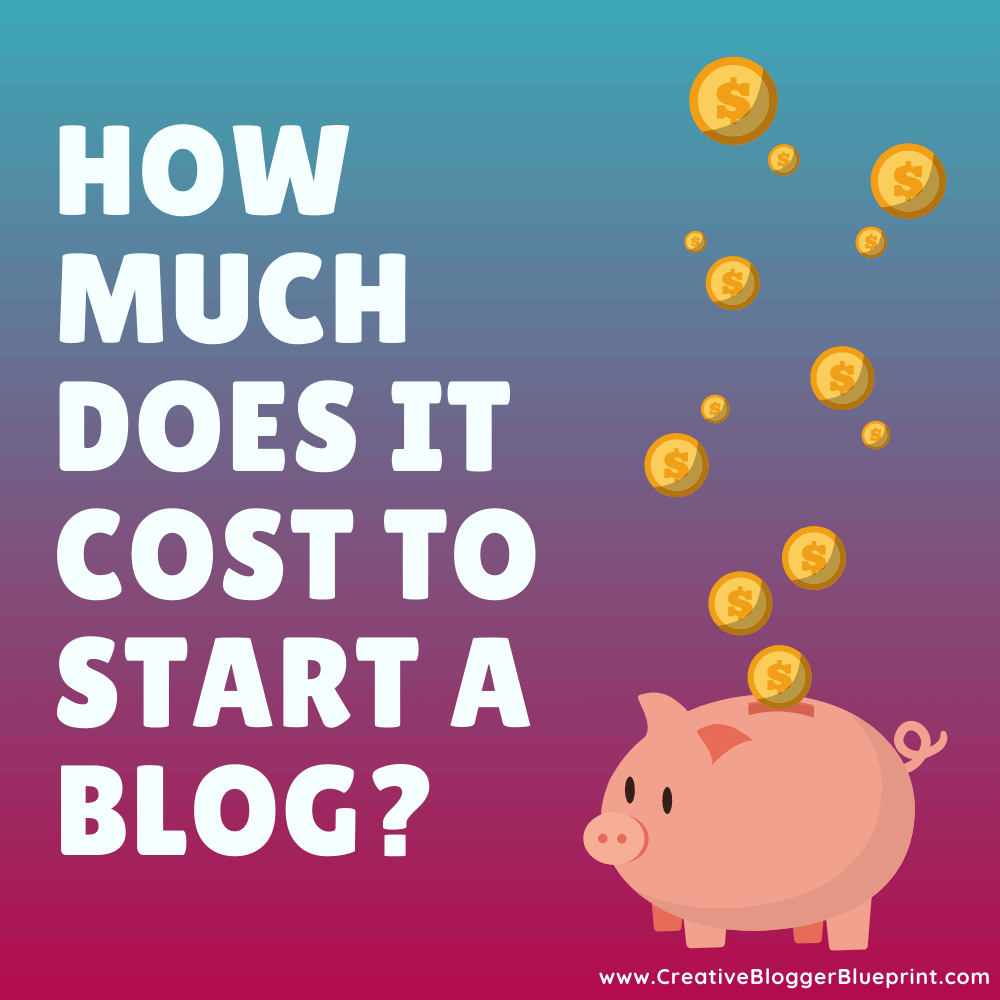
How Much Does It Cost to Start A Blog?
Blogging might be one of the most inexpensive businesses to start. All you really need is a website and a good internet connection. Of course, like most things in life, you can spend more if you want to pay for a fancy theme, logo or hire someone to design your website for you. But you definitely don’t need any of those expensive things and can create a really nice website for minimal cost.
In fact, you really only need 3 essential things:
- A good host. A host is a company that manages the computer servers that store all your blog files and information and makes it available online.
- An internet connection. You very likely have this already.
- Dedication and Perseverance. A successful blog requires a ‘sticking with it’ mentality and a willingness to do the work required to get rewarded later.
As your blog grows, you might want to invest in a few more things:
- A more professional theme (I use themes from Feast Design Co that range in price from $75-$125, but you can find other themes in different price ranges if you don’t love your free theme)
- An Email Service Provider (ESP). Growing your email list is an important part of growing an online business. The providers I recommend are free up to 1,000 subscribers, which is great for getting started.
- Premium Plugins. Plugins are small add on pieces of software that enhance your site. Many are free. Some charge a small amount. These are often “nice to have” things, but totally not necessary.
- Software to handle an online shop, course hosting, memberships, etc. This is nothing you need at first and lots of options to suit your budget when you’re ready.
How To Create A Blog
Let’s dive into the details and go over how to start a blog step-by-step!
Step 1: Choose Your Perfect Blog Topic
This is the exciting part.. deciding WHAT it is that you would like to write about! We call this a “niche” which just means your specific subject. For instance, over at Crochet 365 Knit Too, I blog about crochet. “Crochet” is my niche. If I wanted to focus on one aspect of crochet, such as “crochet blankets”, I could do that too. We call this “niching down” which basically means focusing on a segment of a broader topic.
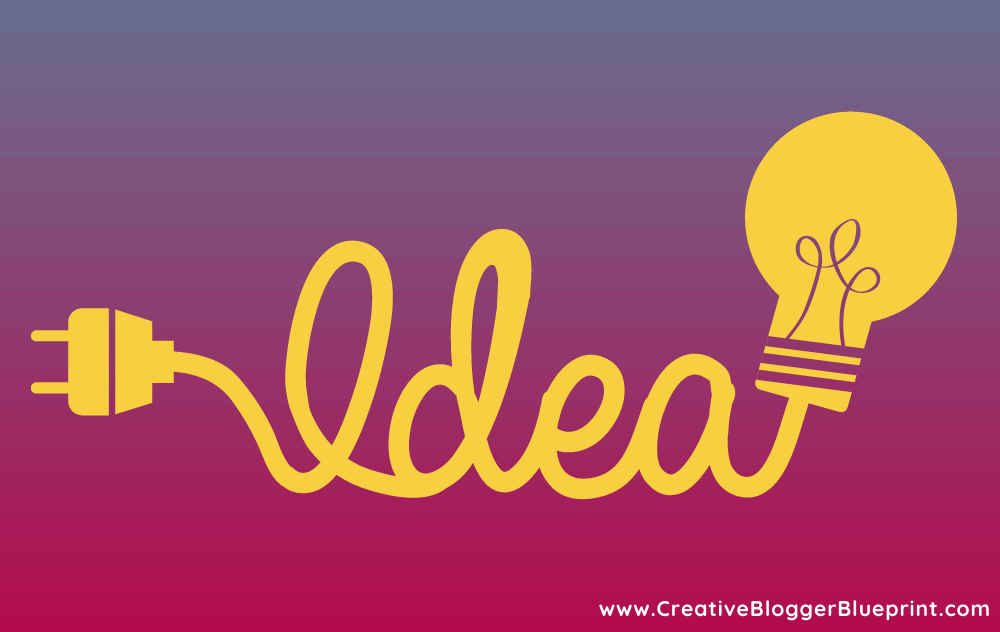
Choosing the “right” niche is important.. but thinking (and agonizing) about it “too” much can sometimes be a road block to actually getting started… and we don’t want that either! I’ve started a lot of websites in many niches over the years. I’ve made mistakes and I’ve watched others make mistakes too. I’d love to save you from those mistakes, so here are my best tips for picking the right niche for you:
Think about what things you love to do. What do you talk incessantly about or spend all your free time doing? Are there other people in the world who are also passionate about this topic? Remember… the world is as big place, so often, if YOU are passionate about something, then you can find others who are equally passionate.
Are you knowledgeable about the subject? Of course, you can learn about a subject and become an expert that way, but it’s good to at least have a working knowledge of your subject matter.
You will be spending a lot of time with this subject. Is this something you think you can write about for a long period of time without getting tired of it? If you love to travel, maybe a travel blog is for you. Maybe a food blog is your thing. The important thing is that whatever your blogging journey, it should be a joyful one…so pick a topic you will enjoy long term.
Don’t talk yourself into a niche you don’t love just because you think it is ‘easy money’. Assuming something is profitable –when it might not even be– and then spending hours on something that bores you will steal your joy. Put your blinders on and ignore what others are doing in niches that are not interesting to you.
Try to stick to one niche. Often new bloggers want to create one site with multiple topics of interest. I really, really discourage this. Let’s take an example.. say you homeschool, you knit and you like to camp so you figure you will do ONE site on all these topics. While you might find the trifecta of readers who share all 3 of these interests, you’re likely going to attract readers from all 3 categories.
Then when you email your entire list or promote to your website, 2/3 of your people will not have an interest in what you’re telling them about! And let’s talk search engines for a minute (Google, I’m talking to you!) Google wants you to be the expert in your topic. They will not see you as an expert in multiple things. And the reason why you care is if you are in the good graces of the search engine, then your content gets shown to more people, which means they visit your site and ultimately make you money. AND ad revenue pays differently depending upon source of traffic… and you guessed it.. search engine traffic pays the most!
You’re really just making life harder for yourself when you tackle multiple niches.
Pick one you love and then meander into the other topics (like how you take your homeschooling on the road in your RV). And.. side note.. there’s always those that do well breaking the rules. A lifestyle blog, for instance, often blurs the lines when it comes to niches.
The most important thing is to get started, so spend a little time on this but then pick your best option and move forward!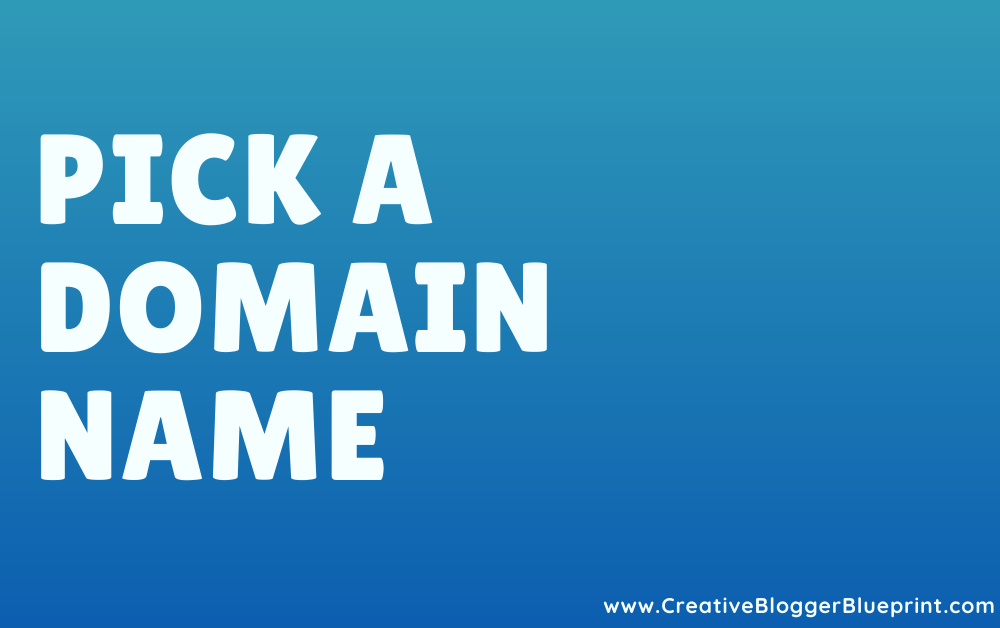
Step 2: Pick a Domain Name
A domain is the name of your website. It is also the address (URL) where users find your website.
Choosing a domain name is an important step. You want to pick the right name and sometimes it seems like “all the good ones are taken”. I always keep a running list of ideas and then go to a site like GoDaddy and see if the domain is available. Here are my best tips:
- Stick with .com It’s the most common and what people expect
- Your domain should be easy to pronounce and spell
- If you can, include your niche keyword
- Pick something unique, catchy and brandable
- Research your domain name to be sure no one else is using it or has trademarked it.
- Act quickly before someone else snatches it up!
Once you know your domain, you have 2 options. You can buy the domain name separately (I buy all my domain names at GoDaddy). Or you can wait and get a domain as part of your hosting plan sign up (sometimes free.. sometimes not). The benefit of buying it separately is that it is not tied into your hosting, making it more convenient if you want to switch hosts later.
If you buy it as part of your hosting, you save money and it is easier because you don’t have to separately connect your domain to your hosting. I buy mine separately, but it’s really a personal preference.
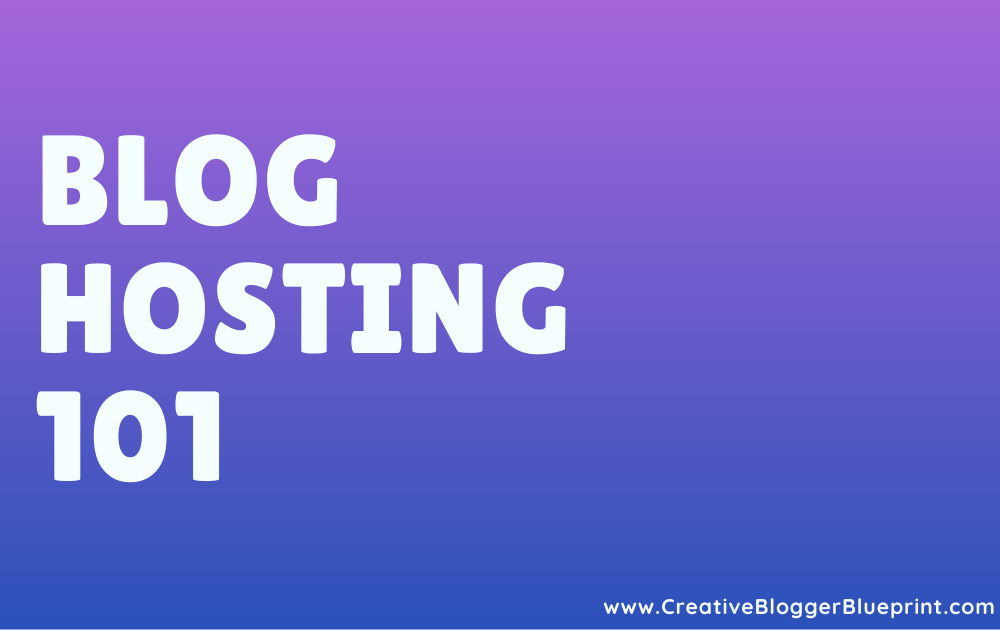
Step 3: Blog Hosting
A hosting company manages the computer servers that store all your blog files and information and makes it available online.
An easy way to think of the process is as if you were building a new house. First you would need to buy the land. For your blog, the land is your hosting.
Then, even though you might be super excited about putting in the kitchen and painting the walls, you need get the framework in place. On your blog, the framework is WordPress.
We’re going to talk about hosting and the framework in this step because they are tied together and you need to understand both before you move forward with your hosting.
In the hosting world you have two options: Low-Cost vs Free. Now, at first, you may think… ‘whoa… free’. But in this instance free is not the way to go if you want to make money with your blog. Free blog platforms like Blogger and WordPress.com can be great for hobby blogs, but have several limitations if you want to make money blogging:
- You don’t own your domain name, THEY do.
- They restrict your money-making opportunities. You can’t run ads and they limit other ways of monetization
- It looks unprofessional and doesn’t look or behave as a trusted source
- Limited bandwidth which means that you’ll have to start paying anyway when you get some good traffic.
By the time you realize a free host is not where you want to be, you may have built up a following and have to essentially start over with a brand-new domain name somewhere else. If that sounds like a headache, well it is. Save yourself a headache and go with a low-cost host instead and get your own custom domain set up. But before we dive into your hosting options, let’s talk really quick about WordPress, which is a blogging platform.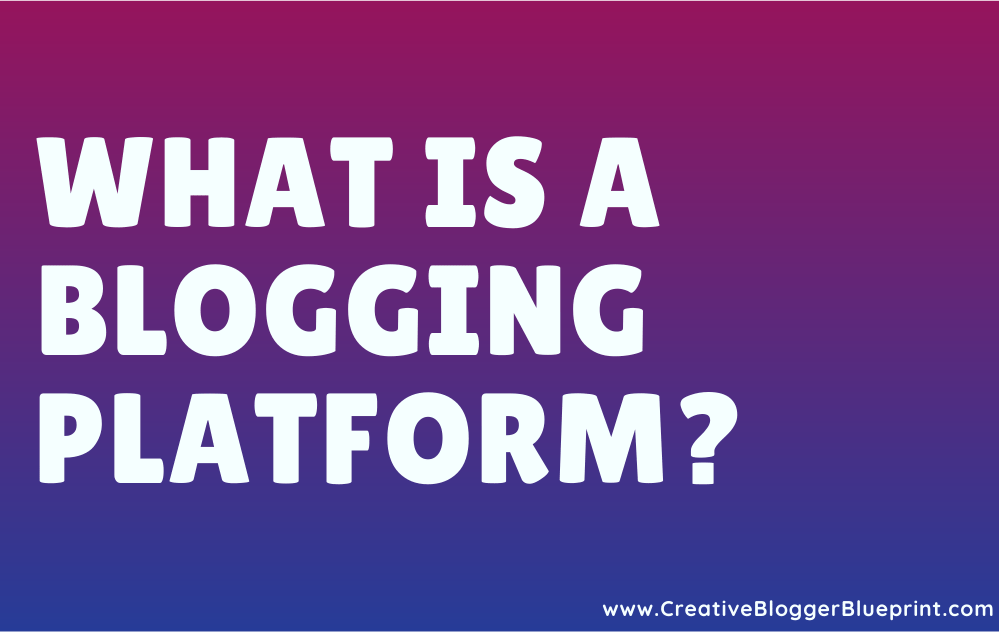
What is a Blogging Platform?
A blogging platform is the software used to manage and publish content on the internet. A blog, short for ‘weblog’ is a listing of entries, usually in reverse chronological order (most recent first).
The difference between a blog and other websites, is that a blog format shows the most recent blog post first. In actuality, though, blogging platforms easily handle static (non-blog) formats too (or you can change to that later if you wish).
Most successful bloggers use a self hosted WordPress blog as their blogging platform because it is so powerful and customizable. It’s also very user friendly. No programming skills are needed.
WordPress.com vs WordPress.org
So you’re thinking.. ‘ok.. I’m in… WORDPRESS it is!’ But then to make things super confusing, there are actually TWO versions of WordPress: WordPress.com and WordPress.org. Neither one will end up costing you anything.. but the WordPress.com version is the free blogging platform we’re trying to avoid.
WordPress.org is the more robust version of WordPress that runs on sites you own yourself! This is the one you want.
But really there’s no reason to think a lot about this, because after you pick your host, they include a WordPress installation process (yes.. it’s that good that it’s already a part of your hosting)!
Just know that there are 2 versions of WordPress and you’ll be getting the best one when you sign up with your host.
Which Host To Use To Start A Blog?
Picking a Hosting Account is a big decision and there are many choices. Important things to consider is reliability and speed (and of course, cost).
As your blog grows and makes more money, you will likely move to a more robust (and more expensive) hosting plan with your current host OR move to a different host altogether. Don’t stress too much about this initial decision. There are pros and cons to every host and you can always change hosts later if you decide your initial choice is not the best for you.
I recommend three different hosting companies. Here is a quick overview of them:
 Bluehost – Best for Beginners
Bluehost – Best for Beginners
Bluehost is a very popular host for starting a blog. Bluehost powers over 2 million websites. It is easy to navigate. It is also a low-cost option at $3.95 per month (billed annually). Be sure to note starting and renewal pricing at sign up, as this sometimes changes.
Other perks include a free domain (if you don’t want to buy one elsewhere), free SSL, free backups (essential if you accidentally break your blog) and 24/7 chat support.
I used Bluehost for Crochet365 Knit Too until I was over 100,000 pageviews a month. I think it is a great option, especially when you are just getting started.
On the downside, some bloggers complain that Bluehost can be a little slow and they sometimes have ‘downtime’ when their site is not accessible. When I was with Bluehost these were not bothersome issues for me. My site speed was acceptable and I rarely had downtime at all (and when I did it seemed to be in the middle of the night for only a few minutes).
I recommend Bluehost to all my family and friends because it’s a great place to start when you don’t know if your idea will take off and you want to minimize your startup costs. Be sure to read my How to Start a Blog with Bluehost post for a step-by-step tutorial. You can get started with Bluehost here.

Siteground – Best for Intermediate Bloggers
Siteground offers great tech support and connectivity. It is a bit more robust and reliable and perfect for Intermediate Bloggers. I use Siteground on one of my niche sites and I think very highly of them.
Benefits include free SSL, Free Backups and 24/7 Chat support. Siteground hosting currently runs between $6.99-$14.99 a month. You can read my How To Start A Blog with Siteground post for a step-by-step tutorial and get started with Siteground here.
 BigScoots – Best for Professional Bloggers
BigScoots – Best for Professional Bloggers
BigScoots is a fantastic option if you’re looking to upgrade your existing blog. I moved Crochet 365 Knit Too to BigScoots after I started getting over 100,000 pageviews a month.
BigScoots offers very fast website speed (which also helps with search engine ranking). Their customer support is very quick and responsive. They offer free SSL, free backups, website staging and more.
BigScoots also offers free migration–which means they take care of moving your site from the old host to their platform. I loved this.. and to tell you the truth, I would have changed earlier if I had known how easy and efficient a process that would be!
BigScoots currently offers managed WordPress hosting for $34.95 a month (billed monthly). You can sign up for BigScoots here.
Step 4: Install WordPress
This is an easy step with any of the hosting plans I recommend because it’s built in! Just follow the Bluehost or Siteground step-by-step tutorials and install WordPress as part of the process. If, for some reason, you missed that step, just reach out to your host’s chat support and they will help you get WordPress set up.
 Step 5: Log into Your WordPress Dashboard
Step 5: Log into Your WordPress Dashboard
Log into your new blog by using the user name and password you chose.
Simply navigate to: https://www.YOURDOMAIN.com/wp-admin
Every time you work on your blog you will do so within the WordPress dashboard. You will quickly get familiar with all the parts and nuances of the WordPress Dashboard!
Step 6: Install a Theme
A WordPress theme is the tool that enables you to customize the appearance of your WordPress blog, including the layout, design elements and typography. Think of your theme as your blog design or blog template .. how it looks and feels. Many new bloggers like the Astra theme as it is a good free theme.
You can also purchase a WordPress theme. I use the Genesis Framework with a child theme on all my sites. This is basically “parent Genesis theme” and then a child theme on top of that. At the moment I’m running the Foodie Pro child theme by Feast Design on Crochet 365 Knit Too and Seasoned Pro also by Feast Design on this site and on my niche site. I love their nice, clean look and that they work well for SEO.
Feast Design caters to food bloggers, but, obviously, you can use the WordPress theme on non-food blogs too. There are other good WordPress blog themes out there. Just do a bit of research first to make sure you like it and that it suits your needs before paying for a theme.
 Step 7: Write Your First Posts
Step 7: Write Your First Posts
This is the step in how to start a blog where you get everything set up in your WordPress blog. Here are the important things to do:
- Customize your theme.
- Create your About Page (make sure you include a way for people to contact you)
- A good profile picture (likely included in your About Page and perhaps in the sidebar)
- Legal pages (such as a privacy policy, terms and conditions and a disclaimer page)
- Links to your social media pages
- Write your first blog post and shoot for 3-5 pillar posts of great content
- Set up an easy to understand blog menu so visitors can navigate your website
Step 8: Promote Your Blog
Go forth and get traffic to your new blog! Sure.. that sounds easy.. but how does one even go about that? How do you get traffic to that amazing blog post you just wrote?
Building blog traffic can be the hardest part of blogging, but you can learn strategies to bring in traffic and once you do, you can start to make money with your website.
Be sure to read all my tips on how to Promote Your Blog.
Step 9: Grow Your List
One of the most important steps in how to start a blog is building an email list. If you’ve been in any blogging groups, you’ll see the phrase “the money is in the list” repeated over and over again. Building a good email list of loyal fans is one of the very best things you can do for your business. Why? Because you own your list.
Social media platforms and search engines can and do change their algorithms all the time. They do not tell you their algorithms. And sometimes it feels like when you finally ‘have it figured out’, something changes.
Not so with your email list. Once your fans are on your list you can email them whenever you so desire to tell them about your great content and all the amazing things you are doing and that you recommend.
Humans buy from people they know and trust. When you connect with your reader as a friend, they will trust you. Then, later, when you tell them about things you think they will like, they will visit the places you recommend.
Building an email list and connecting with readers is my super power. Be sure to read How to Grow an Email List for even more information.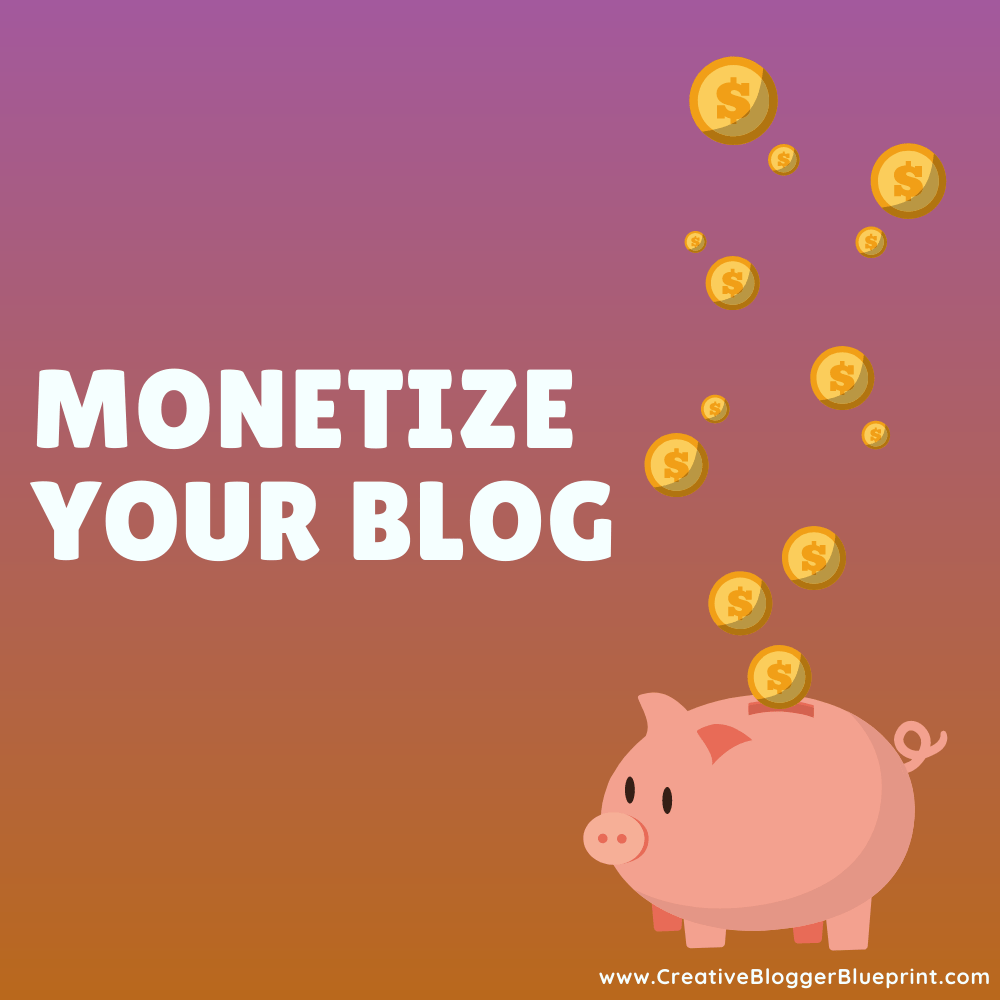
Step 10: Monetize Your Blog
Maybe you thought one of the first things we’d cover in how to start a blog would be how to make money. Maybe you’re even dismayed to find the money making part towards the end of the process. But the truth is that you can’t sell a thing if you don’t have an audience.
And you can’t get an audience if you don’t have something free that they want.
So here at Creative Blogger Blueprint we focus on doing things in the right order so that you can best maximize your time to make money as quickly as possible.
We have a whole section on How to Make Money Blogging where we go over all the methods, how they work and how to get started!
 Step 11: Invest In Yourself
Step 11: Invest In Yourself
Wouldn’t it be great to shortcut your way to success? While there is definitely good information online on how to start a blog (and grow a blog with great content) for free, it can be hard to find. And even worse… there is a lot of bad information and bad advice out there too!
I’ve wasted a lot of time over the years looking for good advice and following bad advice… time that I could have better spent building my business and making money.
I’ve wasted time and money on ebooks and courses too that turned out to be not-so-great and that is super frustrating too.
That’s why all my ebooks and courses are based on my own successful experiences. I actually DO the things I teach.. I do them WELL .. and I make good money using the same techniques in my own business. I am NOT one of those bloggers who jumped into teaching about blogging without any real experience in actually making money blogging!
I have built a 6 figure plus blog with deliberate strategies that work. I’ve helped other bloggers employ the same strategies on their own sites and they’ve worked for them too.
Of course, there’s never any guarantee that what works for me will work for everyone. But I think it helps when it comes from a place of success.
I’ve also taken many courses, read many ebooks, tried many things. Some good and some not-so-good. I share all my favorites on the Tools and Resources Page. Be sure to check out this gold mine to help rocket you to success.
Next Steps After Learning How To Start A Blog
Just keep going! Blogging is really a continuous juggling act.. write a blog post .. promote it.. connect with your email readers.. and make money. The key is balance and keeping yourself organized. Here are best tips:
- Make Time: Decide when and where you will work on your site
- Be Intentional: Whether you are writing a blog post, creating a product or emailing your list, plan what you will work on, put your nose down and actually work that plan.
- Don’t Get Sidetracked: Social Media chit chat is 99.9% of the time NOT actually working on your blog. It’s important to network and connect with readers and others in your niche, but allocate specific time to it and then stop when that time is up. Seriously. This is so important you may need to read it again.
- Successful people are willing to do what others are not. Almost every new blogger faces skepticism from family and friends at first. This turns into amazement at what they think must be “easy money”. The truth is that blogging is hard work, especially at first. You will put in many hours before making your first dollar. Having the stick-to-it-iveness (if that is a word) is one of the most important traits of successful people.
- Be willing to fail, pivot and learn. Not everything you do will be amazing. But as it is in life, some of the best lessons come out of failure. You rise. You get up, brush yourself off and you do better the next time.
- Be sure to read my posts on How to Promote Your Blog, How to Grow your Email List and How to Make Money Blogging
A blogging business can be very rewarding and you’ve taken the first step by learning how to start a blog. Congratulations and I can’t wait to share your journey!
 Common Blog Terminology (in Alphabetical Order)
Common Blog Terminology (in Alphabetical Order)
Advertising (or Ads): Ads are a common way bloggers make money on blogs. Typically, the blogger will work with a network such as Google Adsense, Mediavine or Adthrive to place ads on her site. Be sure to read my post on how to make money with your blog.
Affiliate Marketing: Another common method for making money a blog is to promote another person or business’s product as an affiliate and, in exchange, receive a small commission.
Big Scoots: Big Scoots is an excellent hosting platform that I recommend to professional bloggers. Currently this site and my main site, Crochet 365 Knit Too, is hosted on Big Scoots.
Blogging Platform: A blogging platform is the software or service used to publish content on the internet.
Bluehost: Bluehost is a low cost, easy access hosting provider recommended for beginner bloggers.
Content: The information on your blog or website is “content”. A blog post, for instance, is one form of blog content.
Content Marketing: This is best understood by breaking the phrase into its 2 components: content is the information on your website and marketing is promotion. So, content marketing refers to the strategic marketing of your content to attract and retain your audience.
Digital Products: Products that are available in digital form that end users download. Digital products include ebooks, printables and courses.
Domain: A domain is the name of a website. It is also the address (URL) where users find the website. A domain may be purchased separately from hosting (which is my preference), or one can save money by taking advantage of a free domain when purchasing hosting as most hosts include a free domain as part of the process.
Email List: A list of email addresses of readers who have signed up to receive periodic information.
Genesis Framework: It’s best to think of the back end of your site in layers. First is WordPress which is the platform. Over top of this is the Genesis Framework which governs the design, features and functionality of the site. The final layer is a child theme which works with the Genesis Framework to create the look and feel of the website. Genesis is very popular and there is a lot of functionality to it that makes sites better able to communicate with search engines. I use it on all my sites. However, it is possible to run a theme that does not rely on Genesis.
Google Analytics: Google Analytics is a platform to measure traffic to a website. It provides a lot of detailed data including pageviews, sessions, users, where visitors come from and how they flow through your website.
Guest Post: A guest post is a blog post written on a website by someone who does not own or work for that particular website. Bloggers may wish to guest post on another’s website (with a link to her own website) as a way to send search engine traffic “juice” to her own website. An established blogger may wish to have others guest post on her own site as a way to provide useful information to her readers.
Host (or Web Host): A web host is where your website is stored and managed on the internet. There are my choices for web hosting and my favorites are listed above.
Monetization (or Monetize): Monetization is the strategy for making money. Most online entrepreneurs will have multiple monetization methods and income streams.
Pages: Content on websites are typically contained in pages and posts. Pages are for static content such as disclosure pages, policy pages and ‘about me’ pages. Most blogs have very few pages.
Pageviews: A pageview is a form of measurement tallying the number of times a page is viewed by a visitor. Pageviews are a common metric for the success of a blog (for instance, total pageviews per month). But it is also useful to see which pages get more pageviews than others to measure popularity. It can also help a website owner maximize profit potential by using pageview data to make decisions to improve posts to make more money. Pageviews are most often tracked in Google Analytics.
Plugin: A WordPress plugin is an add-on piece of software that enhances the capability of the software. My advice on plugins is to use only what you need. Many plugins do not play well with one another and some can really hurt your site. They are very useful, but you should research and use them sparingly.
Posts: As mentioned above, content on webpages can be in the form of a blog post or a blog page. Posts are content that can be tagged, categorized and archived. On a website site set up as a blog, the posts are displayed by category in a specific order. Posts can also be organized by categories. For instance, if I make a new crochet afghan and want to send readers to a page with ALL my crochet afghans, I could categorize all those posts the same and the reader would be able to see all those related posts in one spot. Typically, most content on blogs will be posts.
Search Engine: A search engine is an online tool that searches the internet for websites based on the user’s query. It looks for results in its own database then sorts them into a priority list based on its own unique search algorithm. The most popular search engines are Google, Bing and Yahoo, though many other platforms use similar methods to return priority based search results.
Self Hosted Blog (also Self Hosted WordPress): A self hosted blog means that the blog owner pays for a host. This gives the blogger control of the website, how it is designed and built and optimized for search engines. The alternative to a self hosted blog is a free blog (such as Blogger, Tumblr or WordPress.com). A free blog sounds good at first, until you realize that it limits you in so many other ways and can prevent you from realizing your full money making potential. For this reason, I always, ALWAYS recommend a self-hosted blog. Be sure to scroll up to read more about the difference between the two.
SEO (Search Engine Optimization): SEO is the process of maximizing (or ‘optimizing’) your website so that it has a better chance of ranking at the top of the search results. Search engines do not spill the secrets to their algorithms, so learning SEO is often an ongoing endeavor. However, there are many, many things you can do to improve your chances and it makes a lot of sense to spend time mastering SEO for your site.
Sessions: A session measures a period of time a user is active on a website. When a user enters your website, Google Analytics registers the start of the visit and keeps track of that session until the user exits the website.
Siteground: Siteground is a very good hosting platform for intermediate size blogs.
SSL (Secure Sockets Layer): Technology that keeps the internet connection secure and safeguards sensitive data, preventing criminals from accessing details transmitted between the end user and the website.
Theme: A theme is a tool that enables the user to customize the appearance of the site including layout and design elements and typography. All WordPress sites must have a theme to run, but there are many to choose from, including many free themes. You also can choose a premium theme.
Traffic: Internet Traffic is the flow of data over the entire internet. If one thinks about this in ‘real-life’ transportation terms, “traffic” would be any road, path, railway, etc. that gets people from one place to another. When talking about traffic in terms of your own blog, it means the users that actually come to your own website.
User: A user is a visitor who has initiated a session on your website as measured by Google Analytics. A user is identified as either ‘new’ or ‘returning’.
Visits: A general term meaning someone came to a website.
WordPress: WordPress is a web publishing software. It is the simplest, most popular way to create a website or blog.
WordPress.com: Here is where things get confusing (and be sure to read the more detailed explanation earlier in this post on the topic). The short version is that the .com is the free version of wordpress. As counterintuitive as this seems, if you’re looking to make money on your site, you do not want the .com version of wordpress. WordPress.com is severely limited, runs on a modified version of WordPress, looks unprofessional and makes it difficult to monetize your site.
WordPress.org: Most WordPress sites are self hosted WordPress.org sites. Be sure to read the comparison of the .org and .com version of WordPress earlier in this post. Most (if not all) hosts install WordPress as part of the sign up process when you purchase hosting. So, while it is good to understand that WordPress.org just means that you have a self-hosted version of WordPress, you are not actually seeking out and buying WordPress separately.

 Bluehost – Best for Beginners
Bluehost – Best for Beginners
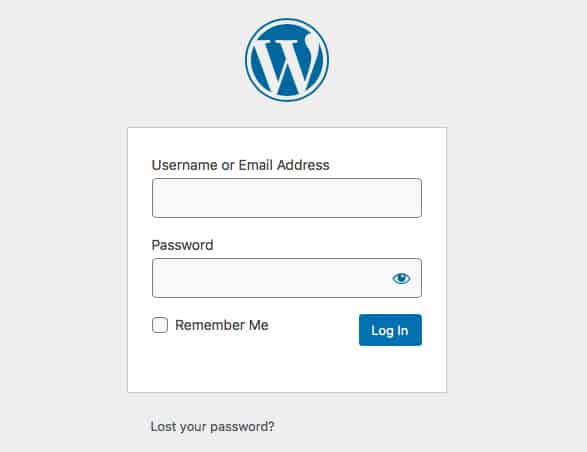 Step 5: Log into Your WordPress Dashboard
Step 5: Log into Your WordPress Dashboard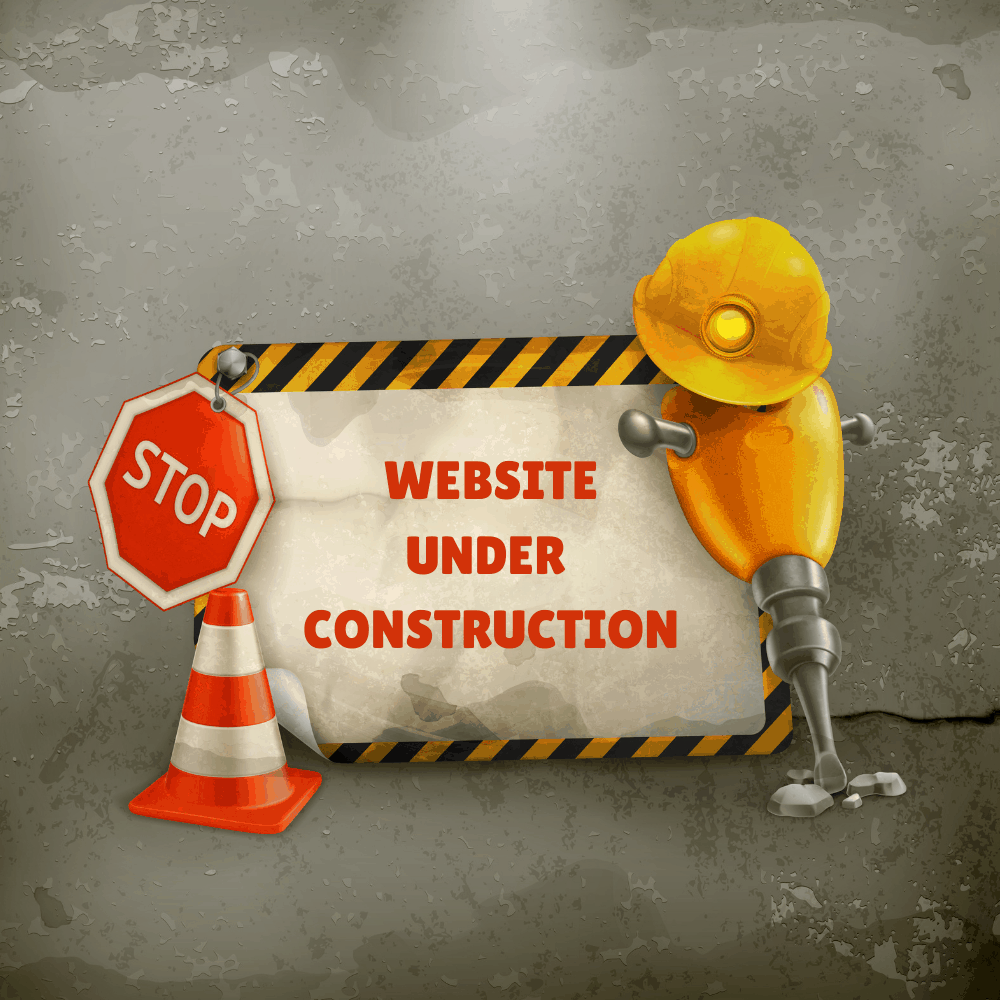 Step 7: Write Your First Posts
Step 7: Write Your First Posts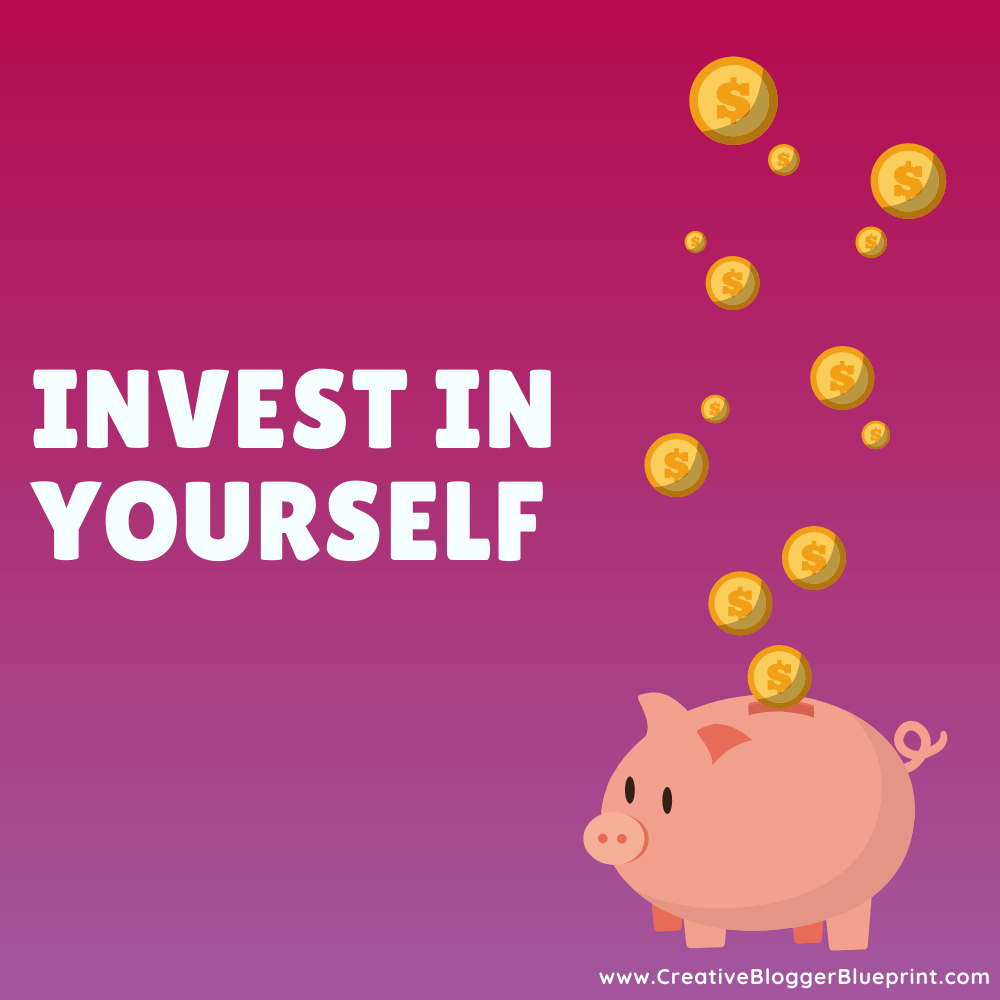 Step 11: Invest In Yourself
Step 11: Invest In Yourself Common Blog Terminology (in Alphabetical Order)
Common Blog Terminology (in Alphabetical Order)
Leave a Reply